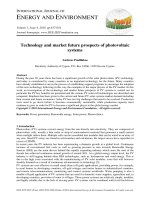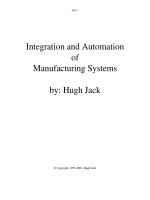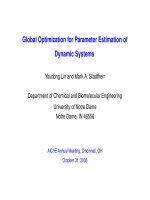- Trang chủ >>
- Khoa Học Tự Nhiên >>
- Vật lý
2dof Forced vibration of two degrees of freedom system
Bạn đang xem bản rút gọn của tài liệu. Xem và tải ngay bản đầy đủ của tài liệu tại đây (849.55 KB, 67 trang )
Twodegreeoffreedomsystems
•Equationsofmotionforforcedvibration
•Freevibrationanalysisofanundampedsystem
Introduction
Introduction
h dd d dbh
• Systemst
h
atrequiretwoin
d
epen
d
entcoor
d
inatesto
d
escri
b
et
h
eir
motionarecalledtwodegreeoffreedomsystems.
f
Nb
masseach ofmotion of s
y
stemin the s
y
stem theof
typespossible ofnumber masses ofNumber freedom of degrees
o
f
N
um
b
er
y
y
Introduction
Introduction
h f d f fd f h
• T
h
erearetwoequations
f
oratwo
d
egreeo
f
f
ree
d
omsystem,one
f
oreac
h
mass(preciselyoneforeachdegreeoffreedom).
• Theyaregenerallyintheformofcoupleddifferentialequations‐thatis,
eachequationinvolvesallthecoordinates.
• Ifaharmonicsolutionisassumedforeachcoordinate,theequationsof
motionleadtoafre
q
uenc
y
e
q
uationthat
g
ivestwonaturalfre
q
uenciesof
qyq g q
thesystem.
Introduction
Introduction
If i it bl iitil it ti th t ib t t f th
•
If
weg
i
vesu
it
a
bl
e
i
n
iti
a
l
exc
it
a
ti
on,
th
esys
t
emv
ib
ra
t
esa
t
oneo
f
th
ese
naturalfrequencies.Duringfreevibrationatoneofthenatural
frequencies,theamplitudesofthetwodegreesoffreedom(coordinates)
are related in a specified manner and the configuration is called a
normal
are
related
in
a
specified
manner
and
the
configuration
is
called
a
normal
mode,principlemode,ornaturalmodeofvibration.
• Thusatwodegreeoffreedomsystemhastwonormalmodesofvibration
correspondingtotwonaturalfrequencies.
• Ifwegiveanarbitraryinitialex citationtothesystem,theresultingfree
vibrationwillbeasuperpositionofthetwonormalmodesofvibration.
However
,
ifthes
y
stemvibratesundertheactionofanexternalharmonic
, y
force,theresultingforcedharmonicvibrationtak esplaceatthefrequency
oftheappliedforce.
Introduction
Introduction
d f h h h f h f f
• Asisevi
d
ent
f
romt
h
esystemss
h
ownint
h
e
f
igures,t
h
econ
f
igurationo
f
a
systemcanbespecifiedbyasetofindependentcoordinatessuchas
length,angleorsomeotherphysicalparameters.Anysuchsetof
coordinatesiscalledgeneralizedcoordinates.
•
Although the equations of motion of a two degree of freedom system are
•
Although
the
equations
of
motion
of
a
two
degree
of
freedom
system
are
generallycoupledsothateachequationinvolvesallcoordinates,itis
alwayspossibletofindaparticularsetofcoordinatessuchthateach
i f i i l di Th i f i
equat
i
ono
f
mot
i
onconta
i
nson
l
yonecoor
di
nate.
Th
eequat
i
onso
f
mot
i
on
arethenuncoupled andcanbesolvedindependentlyofeachother.Such
asetofcoordinates,whichleadstoanuncoupledsystemofequations,is
calledprinciplecopordinates.
Equationsofmotionforforced
vibration
d l ddd f fd
• Consi
d
eraviscous
l
y
d
ampe
d
two
d
egreeo
f
f
ree
d
omspring‐masssystem
showninthefigure.
• Themotionofthesystemiscompletelydescribedbythecoordinatesx1(t)
andx
2(t),whichdefinethepositionsofthemassesm1 andm2 atanytimet
from the respective equilibrium positions
from
the
respective
equilibrium
positions
.
Equationsofmotionforforced
vibration
h l f
d
h
d
l
• T
h
eexterna
l
f
orcesF1 an
d
F2 actont
h
emassesm1 an
d
m2,respective
l
y.
Thefreebodydiagramsofthemassesareshowninthefigure.
• Thea
pp
licationofNewton’ssecondlawofmotiontoeachofthemasses
pp
givestheequationofmotion:
Equationsofmotionforforced
vibration
b h h f l
h
• Itcan
b
eseent
h
att
h
e
f
irstequationcontainstermsinvo
l
vingx2,w
h
ereas
thesecondequationcontainstermsinvolvingx
1.Hence,theyrepresenta
systemoftwocoupledsecond‐orderdifferentialequations.Wecan
thereforeexpectthatthemotionofthem1 willinfluencethemotionof
m
2,andvicaver sa.
Equationsofmotionforforced
vibration
h b f
• T
h
eequationscan
b
ewritteninmatrix
f
ormas:
where [m] [c] and [k] are mass damping and stiffness matrices
where
[m]
,
[c]
and
[k]
are
mass
,
damping
and
stiffness
matrices
,
respectivelyandx(t)andF(t)arecalledthedisplacementandforce
vectors,respectively. whicharegivenby:
Equationsofmotionforforced
vibration
b h h [][] d [k] ll h
• Itcan
b
eseent
h
att
h
ematrices
[
m
]
,
[
c
]
an
d
[k]
area
ll
2x2matricesw
h
ose
elementsaretheknownmasses,dampingcoefficienst,andstiffnessofthe
system,respectively.
• Further,thesematricescanbeseentobesymmetric,sothat:
Freevibrationanalysisofanundampedsystem
•
For the free vibration analysis of the system shown in the figure we set
For
the
free
vibration
analysis
of
the
system
shown
in
the
figure
,
we
set
F
1(t)=F2(t)=0.Further,ifthedampingisdisregarded,c1=c2=c3=0,andthe
equationsofmotionreduceto:
Freevibrationanalysisofan
undampedsystem
d k hh
d
ll
• Weareintereste
d
in
k
nowingw
h
et
h
erm1 an
d
m2 canosci
ll
ate
harmonicallywiththesamefrequencyandphaseanglebutwithdifferent
amplitudes.Assumingthatitispossibletohaveharmonicmotionofm
1
andm2 atthesamefrequency
andthesamephaseangle
,wetakethe
solutionstotheequations
as:
h X
d X
h d h i li d f
w
h
ere
X
1 an
d
X
2 areconstantst
h
at
d
enotet
h
emax
i
mumamp
li
tu
d
eso
f
x
1(t)andx2(t)and isthephaseangle.Substitutingtheabovetwo
solutionsintothefirsttwoequations,wehave:
Freevibrationanalysisofan
undampedsystem
• Sincetheaboveequationsmustbesatisfiedforallvaluesoftimet,the
termsbetweenbracketsmustbezero.Thisyields,
which represents two simultaneous homogeneous algebraic equations in
which
represents
two
simultaneous
homogeneous
algebraic
equations
in
theunknownsX
1 andX2.Itcanbeseenthattheaboveequationcanbe
satisfiedbythetrivialsoutionX
1=X2=0,whichimpliesthatthereisno
ib i F iil li f X
d X
h di f
v
ib
rat
i
on.
F
oranontr
i
v
i
a
l
so
l
ut
i
ono
f
X
1 an
d
X
2,t
h
e
d
eterm
i
nanto
f
coefficientsofX
1 andX2 mustbezero.
Freevibrationanalysisofan
undampedsystem
• Theaboveequationiscalledthefrequency orcharacteristicequation
0}))({(})({)(
2
23221
2
132221
4
21
kkkkkmkkmkkmm
becausesolutionofthisequationyieldsthefrequenciesofthe
characteristicvaluesofthesystem.Therootsoftheaboveequationare
g
ivenb
y
:
g y
Freevibrationanalysisofan
undampedsystem
Thi h th t it i ibl f th t t h tii lhi
•
Thi
ss
h
ows
th
a
t
it
i
sposs
ibl
e
f
or
th
esys
t
em
t
o
h
aveanon
t
r
i
v
i
a
l
h
armon
i
c
solutionoftheform
when=1 and=2 givenby:
WeshalldenotethevaluesofX1 andX2 correspondingto1 as
andthosecorrespondingto
2 as.
Freevibrationanalysisofan
Fth i
undampedsystem
•
F
ur
th
er,s
i
nce
theaboveequationishomogeneous,onlytheratiosand
r2=canbefound.For,theequations
give:
• Noticethatthetworatiosareidentical.
Freevibrationanalysisofan
undampedsystem
Th l d f ib ti di t b
•
Th
enorma
l
mo
d
eso
f
v
ib
ra
ti
oncorrespon
di
ng
t
ocan
b
e
expressed,respectively,as:
• Thevector s,whichdenotethenormalmodesofvibrationare
knownasthemodalvect orsofthes
y
stem.Thefreevibrationsolutionor
y
themotionintimecanbe expressedusing
as:
as:
wheretheconstantsaredeterminedbytheinitial
conditions.
Freevibrationanalysisofan
undampedsystem
Iitil diti
I
n
iti
a
l
con
diti
ons:
Eachofthetwoequationsofmotion,
involvessecondordertimederivatives;henceweneedtospecifytwo
initial conditions for each mass
initial
conditions
for
each
mass
.
Thesystemcanbemadetovibrateinitsithnormalmode(i=1,2)by
subjectingittothespecificinitialconditions.
However,foranyothergeneralinitialconditions,bothmodeswillbe
excited.Theresultingmotion,whichisgivenbythegeneralsolutionofthe
equations
canbeobtainedbyalinearsuperpositionoftwonormalmodes.
Freevibrationanalysisofan
undampedsystem
Iitil diti
I
n
iti
a
l
con
diti
ons:
Sinceandalreadyinvolvetheunknownconstantsand
constants. arec and c where
)()()(
21
2211
txctxctx
wecanchoosec1=c2=1withnolossofgenerality.Thus,thecomponentsofthe
vectorcanbeexpressedas:
)(tx
wheretheunknowncanbedeterminedfromtheinitial
conditions
Freevibrationanalysisofan
undampedsystem
Freevibrationanalysisofan
undampedsystem
Freevibrationanalysisofan
undampedsystem
Frequencies of a mass
spring system
Frequencies
of
a
mass
‐
spring
system
l
d h l f d
Examp
l
e:Fin
d
t
h
enatura
l
f
requenciesan
d
modeshapesofaspringmasssystem,which
isconstrainedtomoveinthevertical
direction.
Solution:Theequationsofmotionaregiven
by:
by:
Byassumingharmonicsolutionas:
thefrequencyequationcanbeobtainedby:
Frequencies of a mass
spring system
Frequencies
of
a
mass
‐
spring
system
• Thesolutiontotheaboveequationgivesthenaturalfrequencies:
Frequencies of a mass
spring system
Frequencies
of
a
mass
‐
spring
system
• From
theamplituderatiosaregivenby:
Frequencies of a mass
spring system
Frequencies
of
a
mass
‐
spring
system
• From
• Thenaturalmodesaregivenby









